Three years ago this week, on February 12, 2009, Agriculture Secretary Tom Vilsack commemorated President Lincoln’s 200th birthday by creating the first USDA People's Garden at the “People’s Department.” This People’s Garden at Department headquarters in Washington D.C., initially started as an opportunity to showcase what we do at USDA, and to unite communities, raise awareness about sustainable agriculture practices, connect people with where their food comes from, and educate on protecting our environment and conserving resources. It was USDA’s way of walking its talk by providing an example to the rest of the country. We’ve grown quite a bit in a short period of time. Thousands of USDA employees and over 700 local and national organizations are participating in over 1,500 gardens.
Last night, the People’s Garden along with Abraham Lincoln, in honor of our namesake and USDA’s 150th Anniversary, recognized employees, agencies and partners for their contributions to the Initiative at The People’s Garden ‘Golden Shovel’ Award Ceremony and Reception. And the categories are…










